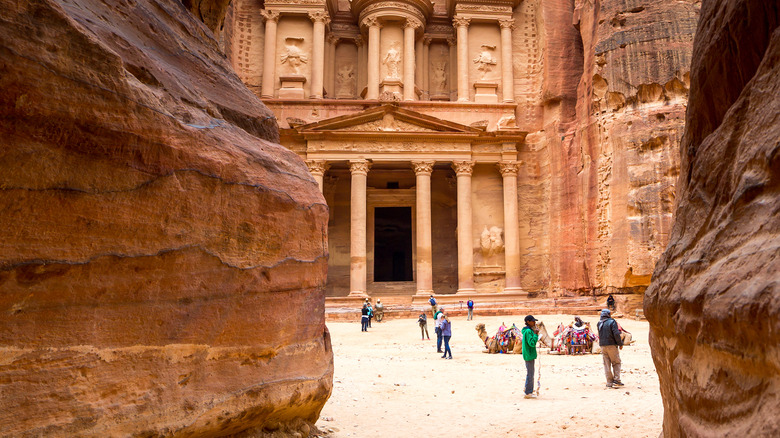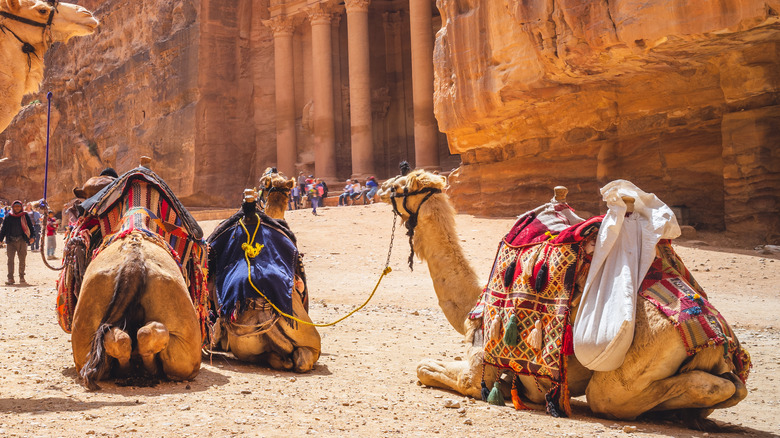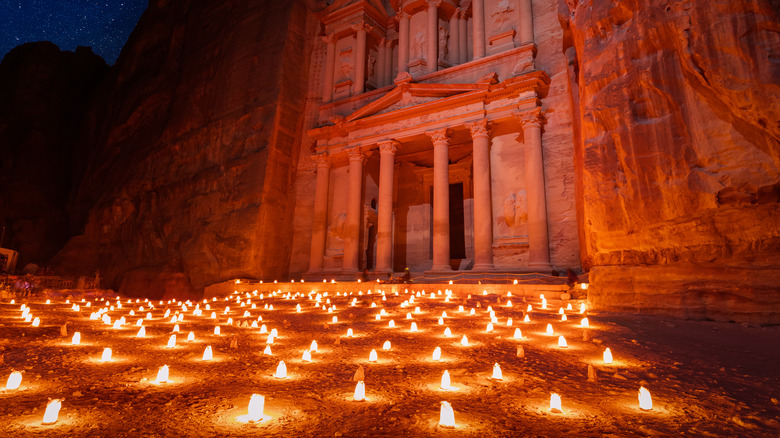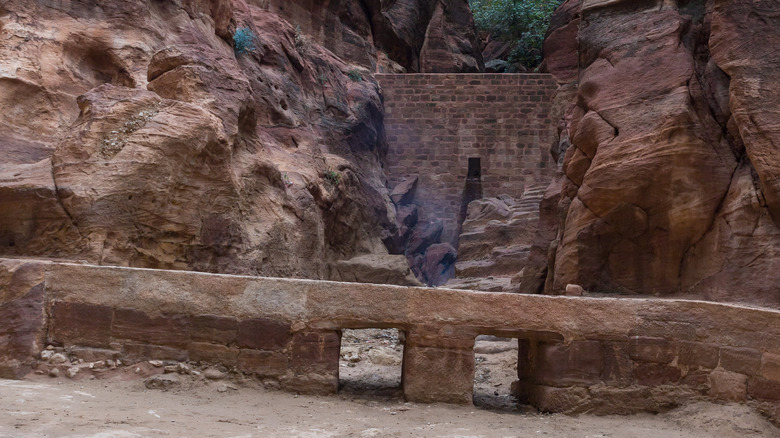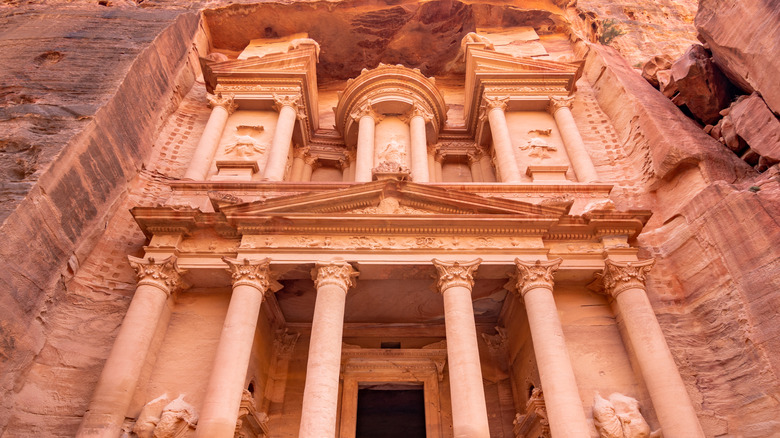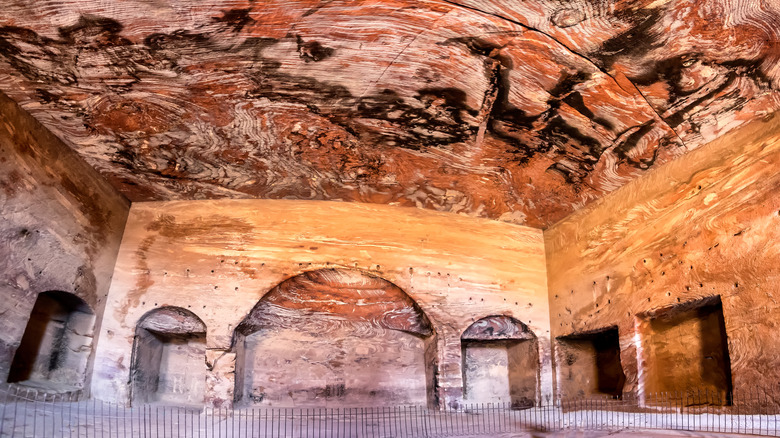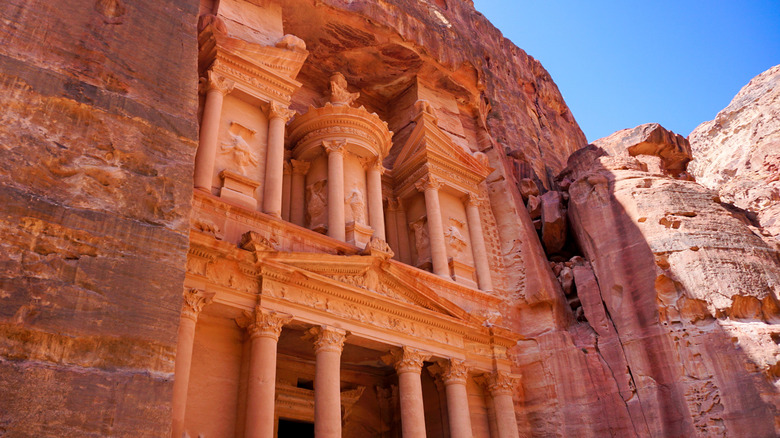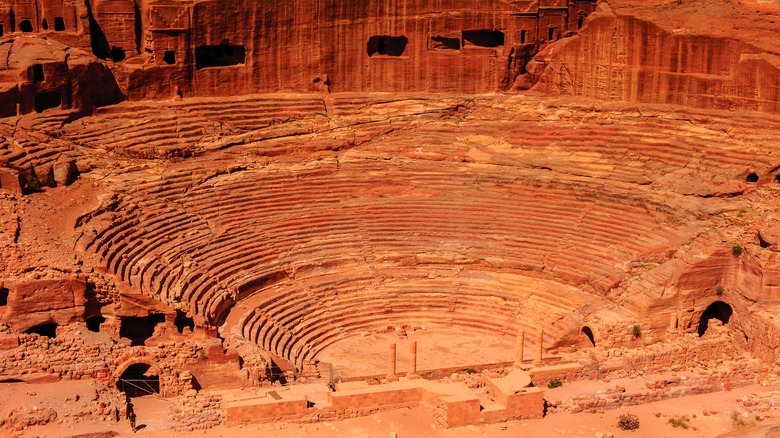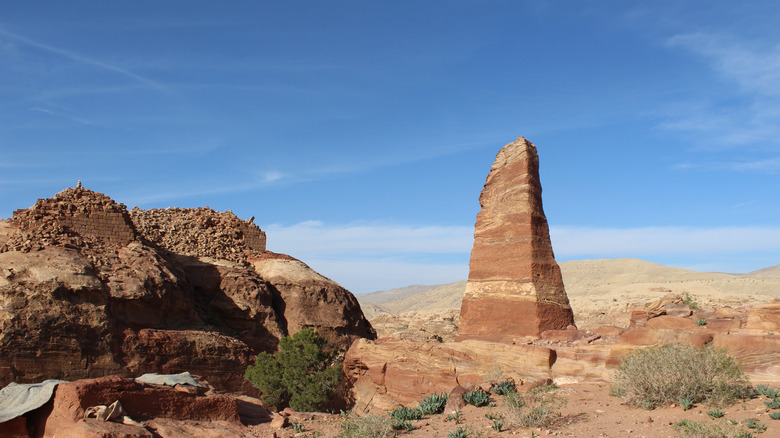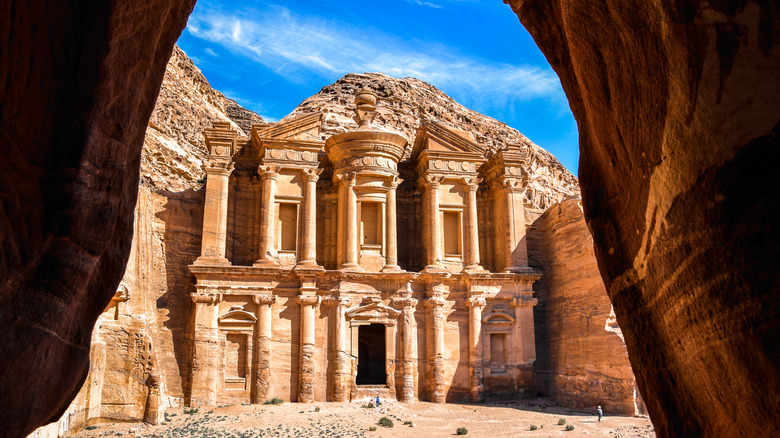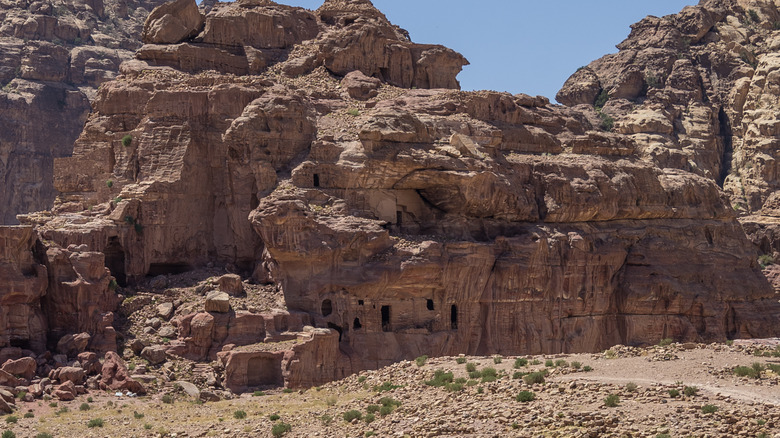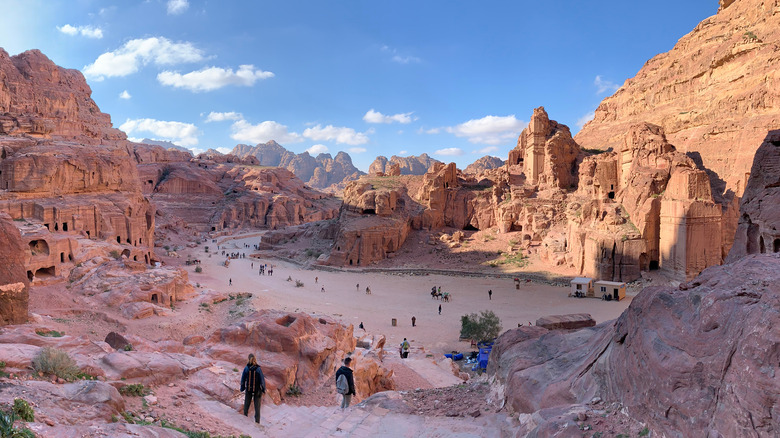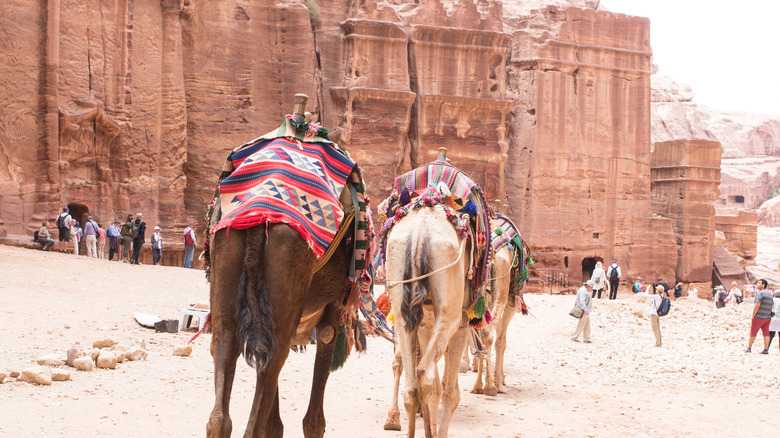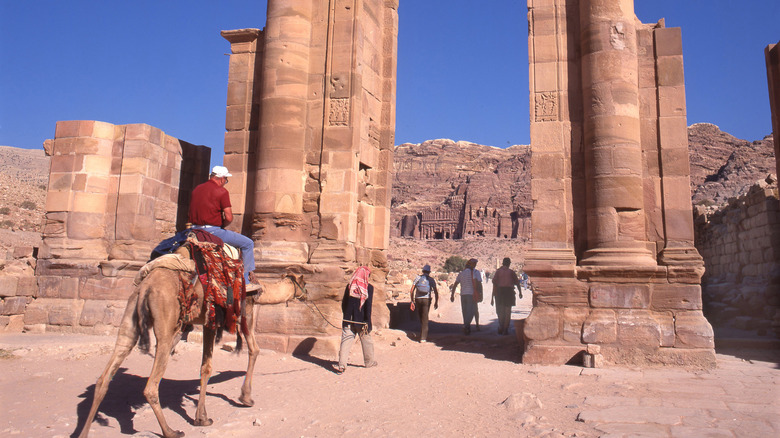The Secrets Of Petra Explained
In Jordan, between the Dead Sea and Red Sea near a nondescript dam sits an opening to the Siq, or Canyon. This narrow, shaded slot canyon seems to open a crack into the world to some different place. Lonely Planet details how the three-quarter-mile hike through the Siq bears an air of mystery and adventure. The tension pays off as, though, around a shadowy bend, a beautiful monumental building peeks out. The traveler has arrived at the lost city of Petra.
This UNESCO World Heritage site is one of the most alluring in the world. Constructed by the ancient Nabataeans as a caravan city from the fourth century B.C. to the first century A.D., its buildings are unique for being carved into the rockface of the natural red sandstone cliffs. It is for this reason that Petra is sometimes called the Rose City. Aside from its aesthetic awesomeness, Petra is a puzzle to be solved. It is neither clear how the Nabataeans built it nor how the city could exist in the first place. It is in one of the most arid locations in the world. But the evidence is there. Petra was a city that defied all odds and became one of the most astounding achievements in history. It is for these reasons that Petra has been included in the list of "New Seven Wonders of the World."
Petra got its wealth from spice and incense
Petra is in a desert valley which doesn't necessarily lend itself to urban development. But the strategic location of Petra made it worth building. UNESCO notes that Petra's location between the Dead and Red Seas made it a crossroads of goods between Egypt, Arabia, as well as eastern and southern Asia. Smithsonian asserts this made Petra an ideal location to control the camel caravan trade. In particular, frankincense and myrrh from Oman passed through Petra as well as spices from India and cloth from Syria.
As a result of its value in world trade, UNESCO states that the region of Petra had been inhabited since prehistoric times. Indeed, Petra was well known both in biblical and Greco-Roman traditions. Britannica points out that Petra was located on the Wadi Mūsā, meaning the "Valley of Moses." This recalls biblical lore which lists it as a location where Moses struck a rock to draw forth water. In the bible, the city was called "Sela" which in the Greek is "Petra." Both terms mean "rock" and refer to the sandstone cliffs upon which it was built.
Petra reached it height under the Nabataeans
Petra achieved the height of its wealth and glory under the Nabataeans. According to the World History Encyclopedia, the Nabataeans were originally nomadic Arabs who hailed from the Negev Desert. They are first known to have been incense traders. Smithsonian adds that they were also active raiders who eventually came to dominate the trade through the region and developed an empire. It was they who built up Petra. Petra was so difficult to get to, especially when one its main entrances was a slot canyon, that it was easily defendable. From that location, the Nabataeans exercised control over trade which came from as far afield as China, raking in wealth through taxation.
While it is not clear exactly when the Nabataeans established Petra, they are known to have been present by 312 B.C. when they are mentioned in Greek records. Yet by that point their kingdom was well established. Petra itself also grew large. According to Britannica, Nabataea prospered and Petra's population grew to up to 30,000.
Petra had one of the best water conservation systems of any time
Despite the benefits of Petra's location, its climate hardly lent itself to sustain a large population. Its chief problem was water — or the lack thereof. As noted by the World History Encyclopedia, there is no natural source of water in Petra. So how did it develop into a city?
The Nabataeans were experts in water conservation. Traditionally, they used cisterns to store water which they hid with signs only they would recognize. This gave them bartering power on the desert trade routes. This skill was applied to Petra. One paper on the subject, "Ancient and Modern Watershed Management in Petra," notes the aridity of Petra's location but also how it was prone to violent, seasonal flash floods. These could be disastrous. In modern times, for example, a group of French tourists in the 1960s were washed away to their deaths by such a flood in the Siq. Curiously, the ancient Nabataeans did not encounter such problems because they were amazing hydro engineers. Using dams, cisterns, aqueducts, and canals, the Nabataeans tamed the flash floods. This provided safety and stopped dangerous erosion from occurring in Petra. This system also allowed the Nabataeans to create a remarkable system of water preservation that essentially made Petra into an artificial oasis.
The architects of Petra were ingenious
The architecture of Petra is renowned since its structures and monuments were carved directly into the sandstone cliffs. Its most awe-inspiring buildings, the so-called Treasury and Monastery, are sculpted in the Hellenistic style (as per National Geographic). Bas-reliefs and Corinthian columns stand out on the red stone. It was clear that the Nabataeans wanted to show the world how prosperous they were.
How the Nabataeans built Petra has long puzzled researchers until laser imaging started to provide clues. Science Focus reports that they first built or carved stone steps along the cliff face. This they would undoubtedly use to inspect the sandstone for quality and feasibility of construction. The masons and artists would then use these steps to carve at the rock face, removing blocks as they reached the ground level. In addition to this, National Geographic also reported that the Nabataeans also may have aligned their city with the Sun. That is so that during important solar events, such as solstices and equinoxes, the Sun would line up with some of Petra's important buildings. While this notion is debatable, proponents state that the Nabataeans may have designed their city in such a way to celebrate worship of the Sun, one of their many deities.
Most people probably lived outside the buildings
There is no doubt that Petra's buildings are magnificent — so much so that Petra's celebrated Treasury was featured in "Indiana Jones and the Last Crusade." However, unlike the movie where Indy quests for the Holy Grail in a cavernous interior, the insides of the buildings at Petra are not vast. For example, National Geographic reports that the Treasury's interior is relatively small. An interior plan provided by NYPL shows only three simple chambers in the Treasury.
The interior architecture at Petra has led many researchers to assume that these buildings were not residences. Rather, Lonely Planet comments that most of the buildings were, in fact, tombs. For some time, experts had assumed that this was the sole function of Petra, much like the necropolises of ancient Egypt. However, after it became clear that people actually lived in Petra, it was a riddle as to where people lived. Some speculated that the Nabataeans, having a nomadic heritage, may have chosen to live their daily lives in tents and saved the monumental stone work to honor their dead. However, recent excavations as detailed in "The Religious Life of Nabataea" show that your average citizen in Petra may have lived in free-standing houses in a domestic quarter of the city. The truth of the matter may become clearer as excavations continue.
The Treasury was not a treasury
The most iconic structure, and a monument to Hellenistic architecture, is Al-Khazneh, known in English as the Treasury. Cleverly positioned at the end of the Siq, it is designed to be the awe-inspiring first site of Petra. According to "The World's Great Wonders," this structure is 12 stories tall and built during the reign of King Aretas IV (8 B.C. — 40 A.D.). While it is called the Treasury, it was clearly not built to be one. Rather, its purpose has been debated between being a tomb or a religious sanctuary or some combination of the two. One major hint at its religious function is pointed out by Rough Guides, which details how there is a basin at the threshold of the Treasury with a channel directed outside. It is likely that this was used for ritual washing and for libations.
As to why it is called the Treasury, the misnomer developed because later people assumed that the magnificent structure clearly was built to hold hidden wealth. National Geographic explains how a large urn carved at the top of the Treasury's façade is riddled with bullet holes. This was because later Bedouins shot at the urn expecting treasure to drop out much like how children may smash open a piñata. What they didn't know is that the urn, like the rest of the façade, is not hollow but made of solid sandstone.
The theater sat up to 4,000
So where did you go for entertainment if you lived in or visited ancient Petra? The Nabataeans carved a full on amphitheater right into the stone. According to the World History Encyclopedia, the finished product, which was built during Aretas IV's reign, is a typical Greco-Roman style amphitheater that could seat up to 4,000 spectators. Archnet explains how the Theater works with the peculiar geology of Petra in which the seating was carved from the sloping rock.
The Romans later renovated the Theater, which is why it is formally called the Roman Theater in modern times. It is also one of the only major structures in Petra that had been renovated in the post-Nabataean era. But "Tourism and Archaeological Heritage Management at Petra" also tells us that the Theater is one of the most tourist-impacted structures in Petra. Erosion is evident from frequent visitors who wear out the original stone mason markings by walking and sitting on the structure.
The High Place of Sacrifice featured blood channels
Petra's High Place of Sacrifice makes no bones about its function. Located atop Jebel Madbah, Lonely Planet explains how this altar was placed in an area that affords the best general view of Petra and its environs. Universes in Universes details how a traveler approaches the High Place of Sacrifice by a 1.2 mile uphill trek from the Theater. Aside from channels that were presumably made to drain the blood from sacrificial animals, the most remarkable detail of the High Place of Sacrifice is its two roughly 20-foot-tall obelisks. While a 20-foot obelisk may seem like no big deal, (the Washington Monument is 555 feet tall) these two were given the Petra stone carving treatment and sculpted directly from the sandstone rather than built atop it. When you consider this fact, then the amount of excavation required to create the obelisks must have been considerable indeed. The thicker of the two obelisks is nicknamed Zibb 'atūf, meaning "Penis of Atuf'" although sometimes this refers to all of Jebel Madbah.
The High Place of Sacrifice is not just blood channels and obelisks. There is also a stone table called a triclinium where ritual suppers were held, as well as a holding place for statues of the gods before reaching a circular altar. This latter structure is adjacent to several basins which were presumably used to ritually cleanse the participants in the sacrifice.
The Monastery was not a monastery
To a modern tourist, Ad Dier, known in English as the Monastery, is one of the most difficult structures to get to in Petra because it is on the opposite side of the site and requires a hike of several miles. But it is worth the visit. Lonely Planet explains how the Monastery is of the same style as the far more visited Treasury. However, it is bigger, being 164 feet wide by 147 feet tall. This building received its moniker from the Bedouins, who, as explained by Universe in Universes, found crosses inscribed inside the rear of the building. However, these crosses came from a later time when the Byzantine Empire controlled the site.
Lonely Planet asserts that the Monastery was a tomb, but Universe in Universes maintains that the Monastery could not have been a mausoleum since there are no tombs inside it. Rather, they suggest that the niches in the rear of the Monastery plus nearby inscriptions indicate that it may have been a home for cultic ritual for the deified King Obodas III who reigned (as per the World History Encyclopedia) from 30 to 9 B.C. Petra's official site maintains that it was simply used for religious purposes. So it seems that the jury is still out on what the Monastery was actually for, but it is certainly awesome to look at.
There are other ruins at Petra
While most people visit Petra to see the fabulous stonework on the Nabataeans, the area also features other historical ruins from later peoples. "Science and Technology for the Safeguard of Cultural Heritage in the Mediterranean Basin" explains that the most well-known of these is Al-Wu'eira, which was built by the Crusader king Baldwin I who ruled Jerusalem from 1100 to 1118. According to Universe in Universes, it is likely that the crusaders built this fort and others over old Nabataean or Roman fortifications.
A more direct influence is shown by the Romans who, as described by the American Museum of Natural History, built a long straight, colonnaded road right through the heart of the city. The Romans also had expanded the original Nabatean amphitheater by cutting into its rear and taking out some tombs in the process. This is why the Theater is sometimes called the Roman Theater.
Petra became a lost city after earthquakes struck
In the first century B.C. the Nabataeans began to fall under the sway of the Romans. According to the World History Encyclopedia, in 64 B.C., the kingdom started paying tribute to Rome. Over the course of the ensuing two centuries, Rome insinuated itself more and more in Nabataean affairs. Rome took more and more of their territory until, finally, in 106 A.D., the Nabataean kingdom was completely annexed by the Roman Empire. Nabataea then became the province of Arabia Petrea. This led to a general decline in Petra as trade routes changed. Still, the city hung on and remained a province of the Eastern Roman Empire (or the Byzantine Empire).
But Petra's end was truly hastened by massive earthquakes in about 363 A.D. and 551 A.D. Petra was abandoned shortly thereafter at an unknown date, but probably before the time of the seventh century Arab conquests. There was possibly still some knowledge of Petra in the West until the 12th century when the crusader fortresses were constructed (via Universe in Universes), but after that time it completely fell out of foreign knowledge.
Petra was rediscovered in the 19th century
Petra to most of the world became a lost city. This would change in the early 19th century when the adventurous young Swiss traveler Johann Ludwig Burckhardt exchanged his life of privilege for one of travel. According to Britannica, Burckhardt, who was educated at Cambridge University in London, visited Syria in 1809 under the umbrella of the Association for Promoting the Discovery of the Interior Parts of Africa. His goal was to eventually explore Sub Saharan Africa, and while in Syria, he learned Arabic and the culture with the intent it would help him in his travels. It was during a journey from Syria to Cairo that he heard about Petra, which was well guarded by the local population.
According to Cambridge University, Burckhardt disguised himself in local garb and made up a cover story that he was going there to sacrifice a goat in honor of a former Islamic leader who was buried nearby. In "Travels in Syria and the Holy Land," Burckhardt would recall traveling through the Siq and his impression of the Treasury: "It is one of the most elegant remains of antiquity ... Its state of preservation resembles that of a building recently finished." After Burckhardt, word of Petra quickly spread so that it became the most visited site in Jordan and one of the most visited in the world.
Only a fraction of Petra has been explored
Modern excavations and research at Petra have brought a trove of knowledge to our understanding of the Nabataeans as well as the world they lived in. National Geographic reported that excavations at Petra have only found structures and materials dating only as far back as the second century B.C. However, it is known that Petra was occupied far earlier. One archaeologist from Jordan's Yarmouk University, Zeidoun Al-Muheisen, told National Geographic, "We have uncovered just 15 percent of the city. The vast majority — 85 percent — is still underground and untouched."
One example of such a discovery was in 1993, when according to "The Petra Scrolls," 152 scrolls dating from the Byzantine period in the sixth century were uncovered in an excavation. Another recent discovery was only made possible by modern technology. The BBC reported in 2016 that satellite imaging and drones were able to identify a large monument buried in the sand. Identified as a platform even larger than an Olympic swimming pool, it is supposed that it was used for religious ceremonies.
What is clear is that despite its world renown and the hundreds of thousands who visit Petra yearly, only a fraction of its secrets have been uncovered. This makes Petra perhaps the most alluring archaeological site in the world.
